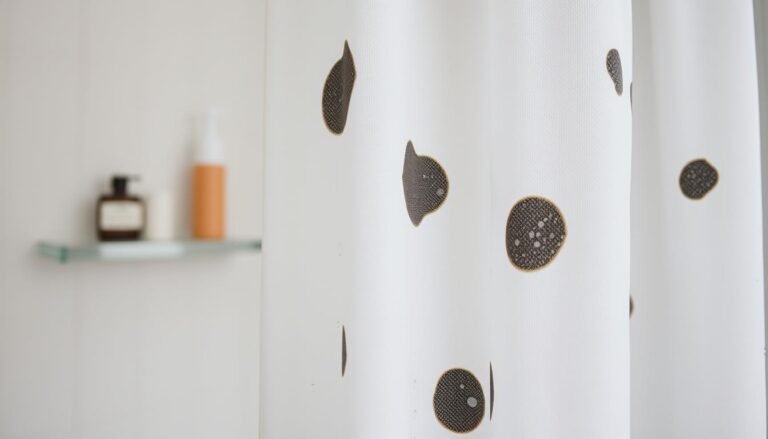How Often to Clean Your Shower Curtain: A Guide
Keeping a clean shower curtain is key for a healthy bathroom. It stops mildew and keeps your bathroom smelling clean. Marla Mock suggests washing your curtain and liner every month to stay mildew-free. Having two sets of curtains helps. You can use one while the other is getting cleaned.
It’s important to clean your curtain the right way, depending on its material. For fabric curtains, wash them with white towels for extra cleaning power. For plastic curtains, be gentle. Adding distilled white vinegar in the rinse cycle helps remove grime.
To keep your shower curtain fresh, spray it daily with water and distilled white vinegar. This stretches the time between deep cleanings. Following these steps will help keep your shower area clean and nice.
Why Regular Cleaning of Your Shower Curtain is Essential
Shower curtains are exposed to moisture every day. This makes them a perfect place for mold and mildew to grow. Keeping your shower curtain clean slows down microbial growth. Mold can start growing on a curtain in just 24 to 48 hours.
Mold spores and toxins can be harmful when breathed in or touched. So, it’s important for your health to keep the curtain clean.
Cleaning your shower curtain does more than make it look good. It keeps your home healthy. Light-colored curtains show stains more and need cleaning regularly. Mrs. D recommends using laundry detergent, bicarbonate of soda, and tea tree oil for a deep clean. Also, mixing cleaning solutions can create toxic fumes, so it’s best to avoid this.
Taking good care of shower curtains means washing them at least once a month. This reduces mold and bacteria. For bathrooms that aren’t used much, washing the curtain every two months works well. PlumbNation suggests changing or cleaning your shower curtain twice a year for the best hygiene.
Rotating your shower curtains each month is a smart move. Using a stain remover on tough stains for 30 minutes helps too. Surprisingly, over a third of people have never washed their shower curtain. Regular cleaning is key to keeping your living space healthy.
How Often Clean Shower Curtain?
Knowing how often to clean your shower curtain is key for keeping it fresh. The type of curtain you have, fabric or plastic/vinyl, changes how often it needs cleaning. Let’s explore the best times to wash your shower curtain for top-notch results.
Recommended Cleaning Frequency
For a clean shower area, wash plastic curtains or liners monthly. If that’s too often, aim for every two months. This stops soap scum and mildew from building up.
Fabric curtains need a wash monthly too. This keeps them in good shape and smelling nice. It’s also smart to get a new curtain every six months to keep things fresh.
Factors that Influence Cleaning Schedule
How often you clean your shower curtain depends on a few things:
- Usage Frequency: More showers mean more soap scum and mildew.
- Ventilation: Bad airflow makes mildew grow faster, calling for more cleaning.
- Cleansing Products: Certain products, like Tru Earth laundry detergent strips, make cleaning easier.
- Presence of Hard Water: Hard water leaves behind minerals, requiring frequent cleaning.
A quick daily spray with vinegar or using a non-soap bar can make your curtain last longer between washes. Getting shower liners on subscription also helps keep things clean with less hassle.
| Type of Shower Curtain | Recommended Cleaning Frequency | Why? |
|---|---|---|
| Plastic/Vinyl | Monthly | Prevent soap scum and mildew |
| Fabric | Monthly | Avoid buildup and odors |
| Replacement | Every six months | Ensure long-term cleanliness |
Best Way to Clean Your Shower Curtain
Keeping your shower curtain clean is key to a fresh bathroom. You can clean fabric and plastic curtains with certain methods. What works best depends on the curtain type and dirt level.
Fabric shower curtains should be washed in the machine every three months. Wash monthly if they get wet often to stop mold and germs. Use warm water, mild detergent, the highest water setting, and a gentle cycle.
Plastic or vinyl curtains can go in the machine too. Wash them in cold water with a few bath towels to avoid wrinkles. For materials that can’t be machine washed, hand wash them. A vinegar and water mix cleans well.
If the curtain is very dirty, soak it before washing. Use baking soda and vinegar in the rinse for extra mildew protection.
When you can’t machine wash, hand wash the curtain in warm water. Use baking soda and a gentle detergent. For hard stains, use a mixture of bleach and water.
- Remove the shower curtain from the rod.
- Place it in the washing machine with some bath towels.
- Add mild detergent and choose the right water temperature.
- Optional: Add ½ cup baking soda for the wash cycle and ¼ cup vinegar for the rinse cycle.
- Hang the curtain to dry or tumble dry on low heat if the label says you can.
To avoid mold and soap scum, spray the liner with vinegar weekly. These methods work for 75% of curtains and liners. Clean thoroughly in the machine each month for best results.
To clean effectively, know the needs of different materials. For more hygiene tips, check out this bed cover cleaning guide. It has useful advice.
| Material | Cleaning Method | Frequency |
|---|---|---|
| Fabric | Machine Wash | Every 3 Months / Monthly if Frequently Wet |
| Plastic/Vinyl | Hand Wash or Machine Wash | Monthly |
| Synthetic (not machine-washable) | Hand Wash with Vinegar and Water | Monthly |
By using these cleaning tips, your bathroom will stay healthy and welcoming. Whether by machine or hand, the right methods keep your shower curtain clean and fresh.
Tips for Cleaning Fabric Shower Curtains
Keeping your shower curtain clean and durable needs regular care. It’s important to know the best ways for machine and hand washing. Follow these cleaning tips to make your bathroom look and smell great, regardless of the curtain’s material.
Machine Washing Instructions
Machine washing helps keep your curtain in top shape. First, take off the rings. Choose a gentle cycle on your washer and fill it with the highest water level. Add a couple of bath towels to the mix. They act like scrubbers, cleaning the curtain more effectively.
To boost cleaning, mix in half a cup of baking soda with your detergent. But remember, bleach is a no-go. It can ruin the curtain’s colors and fabric.
Clean your shower curtain every month to keep it fresh. Seeing mold or brown spots even after a wash? It might be time for a new curtain. For fancy curtains, especially those made of 100% cotton, use a gentle linen wash. It cleans well without causing harm.
Handwashing Techniques
Handwashing works great for sensitive fabrics. Lay the curtain in the tub and dampen it. Sprinkle either baking soda or detergent over it. Then, using a soft brush or sponge, gently clean it. This gets rid of soap film or mildew. Rinse with cold water to remove any cleaning agent leftovers.
Stuck with stubborn stains? Try soaking the curtain in a mix of baking soda and vinegar first. Always air dry the curtains for the best results. By hanging them in an airy place, they dry uniformly without smelling bad.
Switch out your shower curtains each month to keep them looking good. It’s smart to have two curtains for each bathroom. This way, you always have a clean one ready. Following these cleaning tips can really make a difference in your bathroom’s cleanliness and in the lifespan of your curtains.
Looking for more advice on boosting your home’s efficiency? Check out this guide for some handy tips.
Effective Methods for Cleaning Plastic Shower Curtains
Plastic shower curtains are popular for their function and affordability. Yet, keeping them clean is key to avoiding mold in your bathroom. You can choose between machine washing or handwashing to keep your curtain looking new.
Machine Washing Steps
Machine washing is a good way to clean your plastic shower curtains. This is perfect for those wondering about cleaning frequency. It’s best to do so monthly or every three months. Here’s what to do:
- Take the curtain off and check for mold or mildew.
- Put it in the washer with a few towels to help scrub.
- Use half a cup of both white vinegar and baking soda, plus a bit of gentle detergent.
- Choose a gentle cycle with cool water to avoid damage.
- After washing, hang it up to dry. Avoid the dryer to prevent damage to the plastic.
These steps can keep your curtain free of mold and looking great.
Handwashing Tips
If you prefer cleaning by hand, it’s quite effective, especially for tough mildew or delicate curtains. Here’s what you should do:
- Fill the tub with warm water and a lot of mild detergent.
- Submerge the curtain and let it soak for 10-15 minutes.
- Scrub it gently, especially the corners and edges where buildup happens.
- Rinse well with clean water.
- Hang it up to dry fully before putting it back.
Regular handwashing stops grime buildup, keeping your curtain fresh. Using these cleaning steps helps maintain not only your curtain but also the cleanliness of your bathroom.
Maintaining Your Shower Curtain for Long-Term Hygiene
Proper shower curtain maintenance keeps your bathroom clean and welcoming. To make your shower curtain last longer, let it dry fully after use. This reduces humidity and stops mold from growing. Keep the room airy by using fans or opening windows.
To keep your shower curtain clean, wash it monthly. Use Tru Earth’s eco-friendly laundry strips for this. They’re safe for the environment and your health.
Washing your plastic curtain by hand also works well. Mix baking soda with water on a cloth for this. Clean deeply every few months to keep it fully hygienic.
Switching between different shower curtains can brighten your bathroom. But, remember to replace them regularly. Plastic ones last 6 months to a year. Fabric ones need changing every 2 to 3 years.
Adding a shower curtain liner helps too. It shields your main curtain from water. This keeps it clean for longer. Clean regularly to ensure your bathroom stays healthy.
Making shower curtain cleaning a habit is key for a neat bathroom. Proper care means more than just good looks. It leads to a healthier, fresher home.
Choosing the Right Cleaning Products for Your Shower Curtain
When picking cleaning products for your shower curtain, selecting the right ones for the material is key. For both fabric and plastic/vinyl types, natural products like baking soda and vinegar work great. These options clean well and help your curtain last longer. Baking soda gently cleans plastic without scratches. Vinegar is great for removing mold and mildew from fabric curtains.
To clean your shower curtain well, use bleach with care. For fabric curtains, soak them for about 10 minutes before washing. Wash or rinse until the water looks clear. If cleaning plastic liners, let them sit in bleach for 10-15 minutes. Scrub with baking soda and dish soap, then rinse well. This keeps your curtain free from residue. Using too much cleaner can damage your curtains.
Signing up for a shower liner replacement service is also smart. It keeps your shower clean by regularly changing the liner. This stops dirt from building up and makes your bathroom look fresh. For tips on picking the right cleaning products and techniques for your shower curtain, check out this detailed guide.

Hey there, I’m Alex Hanson and I’m passionate about all things covers! Whether you’re looking for a car seat cover to protect your vehicle or an oven cover to keep your kitchen clean, I’m here to help. With years of experience in the industry, I have plenty of knowledge and insights to share with my readers. So, if you care about protecting your belongings and making them look their best, you’re encouraged to read my blog as I explore the perfect cover for every need.







